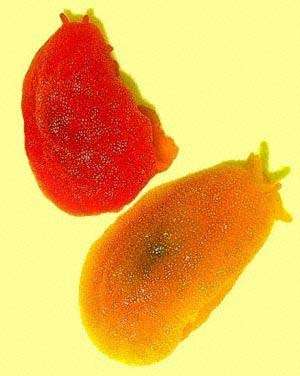

Berthellina citrina
(Ruppell & Leuckart, 1828)
Order: NOTASPIDEA
Superfamily: PLEUROBRANCHOIDEA
Family: Pleurobranchidae
DISTRIBUTION
Common throughout the tropical and sub-tropical Indo-West Pacific, found even in northern New Zealand.
PHOTO
UPPER: Colour variation - Fumba, Zanzibar, Tanzania, July 1971.
LOWER: Anterior end showing rolled rhinophoral head tentacles and the triangular oral veil. Note the ventral groove that can be seen along the edge of the veil. Koumac, New Caledonia, October 1993. PHOTOS: Bill Rudman.
Berthellina citrina is a common pleurobranch found throughout the Indo-West Pacific and adjacent temperate waters. It often has a small flat shell remnant hidden in the mantle skin above the digestive gland and ranges in colour from a pale translucent yellow through to a bright red. The back is covered in small white gland cells which secrete a milky white defensive secretion.
Berthellina citrina is normally found feeding on a variety of sponges, but Scott Johnson has reported it feeding on the three species of coral: Tubastrea coccinea, Leptastrea sp. and Porites lobata, in Hawaii.
Reference:
• Willan, R.C. (1984). A review of diets in the Notaspidea (Mollusca: Opisthobranchia). Journal of the Malacological Society of Australia, 6: 125-142.
Rudman, W.B., 1999 (March 9) Berthellina citrina (Ruppell & Leuckart, 1828). [In] Sea Slug Forum. Australian Museum, Sydney. Available from http://www.seaslugforum.net/find/bertcitr
Related messages
Berthellina citrina from New Zealand
August 27, 2009
From: Graham Bould
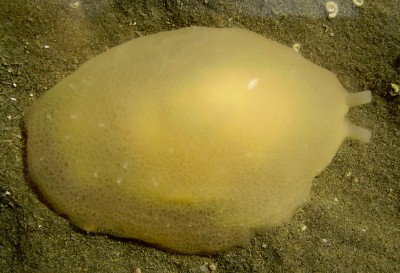
Concerning message #22587:
Are you able to ID this seaslug. It does not appear to have exernal gills.
Locality: Rocks, Low tide level, Whangaparaoa, New Zealand, Pacific, 22 July 2009, Under stone in rock pool. Length: 30 mm. Photographer: Graham Bould.
Graham Bould.
graham@grahambould.net
Bould, G., 2009 (Aug 27) Berthellina citrina from New Zealand. [Message in] Sea Slug Forum. Australian Museum, Sydney. Available from http://www.seaslugforum.net/find/22588Dear Graham,
As with your earlier query on Berthella ornata, this is also a pleurobranch, a group in which the gill - or gills in a few cases - is found on the right side below the mantle skirt. While Berthella ornata is found only in New Zealand, this one, Berthellina citrina, has a wide distribution throughout the warm water parts of the Pacific and Indian Oceans.
Best wishes,
Bill Rudman
Orange slug-like species from Sydney, Australia
May 15, 2009
From: Roland Bircher
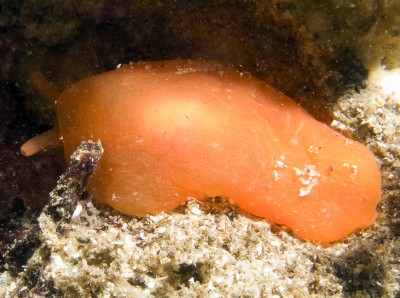
Dear Bill,
I found this orange species on a night dive yesterday. It was living on an isolated overgrown rock at the edge of a little overhang, in close proximity to three specimen of Aphelodoris varia. It was sensitive to/disturbed by the light of my diving torch and the red modeling light of my strobe and moved in reasonable speed under the overhang.
Locality: Bare Island, La Perouse, Sydney, 10 m, New South Wales, Australia, Botany Bay, Pacific Ocean, 14 May 2009, Overgrown rock (weed, sponges) on sand, close to rocky reef. Length: 5 cm. Photographer: Roland Bircher.
I couldn't make out any external gills. The two tube-like extensions (presumably sensing organs) looked like rolled sheets. The back tip of a foot was showing under the mantle (image 2). The body was bright orange-red, the mantle was semi-transparent. All of this doesn't look like the typical nudibranchs I see around here, but the specimen was definitely of slug-like appearance. Could you tell me what family this species belongs to?
The pictures are far from perfect due to heaps of particles and a mishandling of the strobe. The colour of the first photo is reproducing the natural colour best.
Kind regards,
Roland
roland.bircher@gmx.net
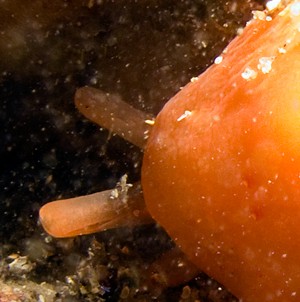
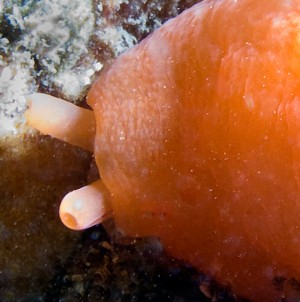
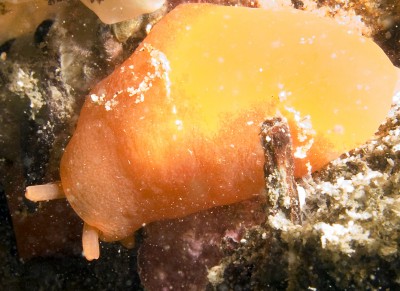
Dear Roland,
The slug shape has evolved many times among the snails. This is Berthellina citrina, one of the pleurobranch or side-gilled slugs. They get the name from the single gill which is attached to the right side of the body below the mantle skirt.
The tube-like extensions you mention are tentacles which suck water down over chemosensory organs so they can check for food 'smells' or danger.
If you look at earlier messages attached to the species' Fact Sheet you will find other information on the natural history of ths species.
Best wishes,
Bill Rudman
Berthellina citrina from the Red Sea
August 14, 2007
From: Lior Harari
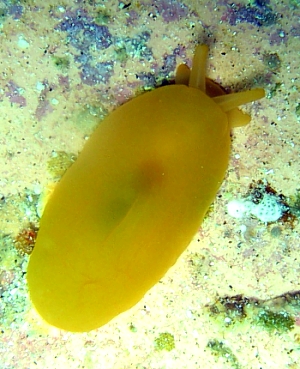
Hello,
I've been meaning to send you these pictures for quite a while, finally got to it. I believe this is a Berthellina citrina. It was found on a long metal pipe at 10 meters of depth. It was the first time (and so far the only time) I spotted one of these.
Locality: Dekel Beach, Eilat, 10 meter, Israel, Red Sea, 04 April 2007. Photographer: Lior Harari.
I have noticed some white spots as well as a few black ones on its body.
Do those serve any purpose?
Thanks,
Lior.
hararilior@yahoo.com
Harari, L., 2007 (Aug 14) Berthellina citrina from the Red Sea. [Message in] Sea Slug Forum. Australian Museum, Sydney. Available from http://www.seaslugforum.net/find/20160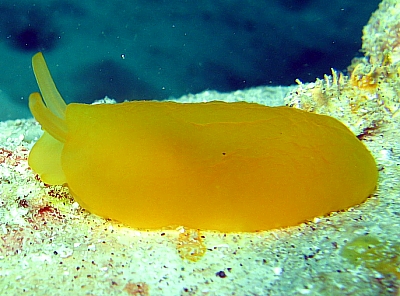
Thanks Lior,
Yes this is what we call Berthellina citrina, but as I've mentioned elsewhere, there is some talk that there is more than one orange-yellow species in the Indo-West Pacific but we will have to wait until some anatomical studies are complete and published.
The white spots are glandular. See the Defensive glands Fact Sheet for a photo of the white acid glands found in pleurobranchs.
Best wishes,
Bill Rudman
Re: Berthellina citrina from Reunion island
June 8, 2007
From: Hugues Flodrops
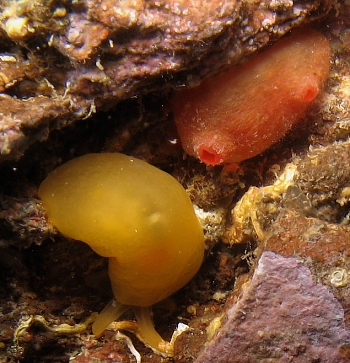
Concerning message #13106:
Dear Bill,
Here are three specimens from Reunion Island with more orange color than specimen of Philibert Bidgrain. In the first one, is it a red sponge above the Berthellina?
Locality: Etang-Salé, 0,5 metre, Reunion Island, Indian Ocean, 23 april and 5 may 2007, By night. Length: 18 mm and 35 mm. Photographer: Hugues Flodrops. Upper image: Etang salé, date observed 23 april 2007, lenght specimen 18 mm, Depth 0,5 metre.Under a rock. Other images: 5 May 2007. Same place. Length specimens : 18 mm and 35 mm. Front view is of the big one.
Thanks again for your time.
Bests regards.
Hugues.
hugues.flodrops@wanadoo.fr
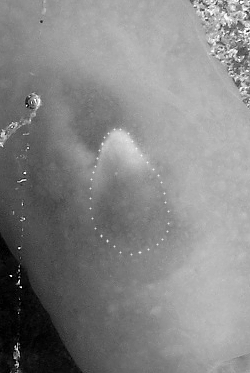
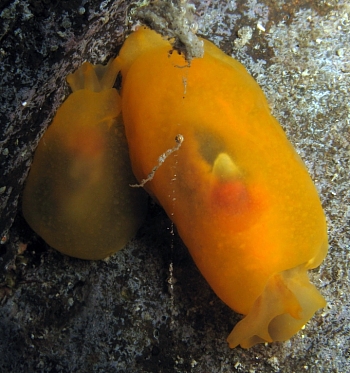
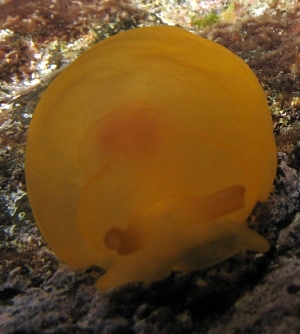
Dear Hugues,
I can be fairly confident that these are Berthellina because I can clearly see the small internal shell [which I have outlined in the gray close-up]. One difference between species of Berthellina and Berthella is that the shell is small like this in Berthellina. However I will call it Berthellina citrina with caution because Lucas Cervera told me he was looking at these animals and had some indications that there was more than one orange-yellow Indo-West Pacific species.
Concerning the red 'sponge' in the upper photo. It is in fact a solitary ascidian. You will see from the Fact Sheet that one of the common names of ascidians is 'sea squirt' because when they are exposed at low tide they sometimes squirt a jet of water out of one of the two siphons you can see in the photo.
Best wishes,
Bill Rudman
Berthellina citrina from the Gulf of Kutch, India
July 29, 2006
From: Arpit Deomurari
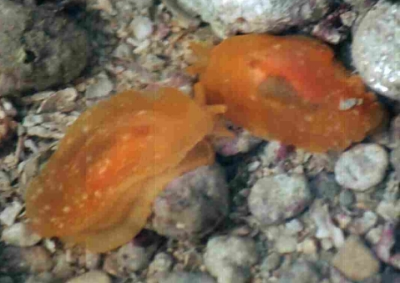
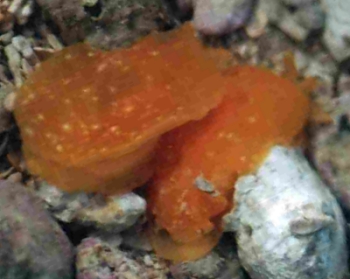
Dear Bill
I found 6 of this sea slug on a reef slope on Paga Reef in the Bay of Poshitra area of the Gulf of Kutch, Gujrat, India. The Paga reef is almost always submerged except when there is a minus tide.
I found 3 pairs which looked like they might be mating. So I didn't disturb them and only took photographs for identification. I need species identification of this species.
Locality: Paga Reef, 3 ft, Gujarat, Gulf of Kutch, Arabian Sea, 15 november 2005, submerged reef exposed on minus tide. Photographer: Arpit Deomurari.
Arpit Deomurari
deomurari@gmail.com
Deomurari, Arpit, 2006 (Jul 29) Berthellina citrina from the Gulf of Kutch, India. [Message in] Sea Slug Forum. Australian Museum, Sydney. Available from http://www.seaslugforum.net/find/17187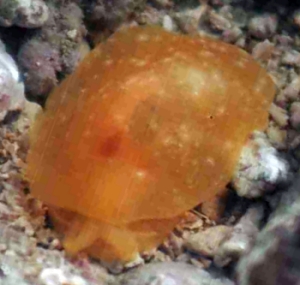
Dear Arpit,
This is a pleurobranch or 'side-gilled slug' and is most probably Berthellina citrina. There is some unpublished work suggesting there is more than one orange Berthellina species in the Indo-West Pacific region, but until that work is complete we just need to be aware that B. citrina may include a number of species.
This is probably the species K.R. Narayanan reported from the Gulf of Kutch, firstly as Berthellina minor Bergh, 1905 (Narayanan, 1969) and then as B. citrina(Narayanan, 1970).
- Narayanan, K. R. (1969) On the opisthobranchiate fauna of the Gulf of Kutch. Proceedings of the Symposium on Mollusca held at Cochin from January 12 to 16, 1968, Symposium Series 3, Pt. 1, Marine Biological Association of India, Mandapam Camp, India.
188-213. Figs 1-20. - Narayanan, K. R. (1970) On a species of the genus Berthellina (Opisthobranchia: Notaspidea) of the Gulf of Kutch. Journal of the Marine Biological Association of India 12: 210-213.
Best wishes,
Bill Rudman
Berthellina citrina from Reunion island
February 12, 2005
From: Philibert Bidgrain
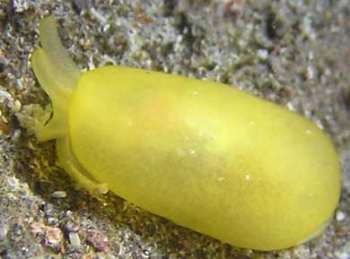
Dear Bill,
Reunion Island sea slugs.
This sea slug, which we think is Berthellina citrina, is relatively common in Reunion Island.
Locality: "Bassin des hirondelles", at Etang salé les bains. Reunion Island, Indian ocean. Length: 10-15 mm. 5 January 2005. permanent pool in intertidal area. Photographer: Philibert Bidgrain
Best Regards
Philibert Bidgrain
http://vieoceane.free.fr/runseaslug/indexslug.htm
pbidgrain@yahoo.fr
Bidgrain, P., 2005 (Feb 12) Berthellina citrina from Reunion island. [Message in] Sea Slug Forum. Australian Museum, Sydney. Available from http://www.seaslugforum.net/find/13106Dear Philibert,
This is certainly a Berthellina. However there is some evidence, unpublished at present, suggesting there is more than one orange-yellow Berthellina in the Indo-West Pacific, which will make identifications difficult. However until that is published, Berthellina citrina is the best name to use
Best wishes,
Bill Rudman
Re: Coral-feeding Berthellina
February 4, 2004
From: Steven Garcia
Thank you for the fantastic information. Now I have to try and catch the critter!
In regards to the Bubble coral, it was a Plerogyra sp. I also caught him eating my 'Java Button', Cynarina lacrymalis.
Again thanks!
Steven Garcia
steven.garcia@diversityworking.com
Garcia, S., 2004 (Feb 4) Re: Coral-feeding Berthellina. [Message in] Sea Slug Forum. Australian Museum, Sydney. Available from http://www.seaslugforum.net/find/12117Dear Steven
In cases like this we help each other. Your observations on what Berthellina is eating are valuable additions to our knowledge
Cheers
Bill Rudman
Coral-feeding Berthellina
February 3, 2004
From: Steven Garcia
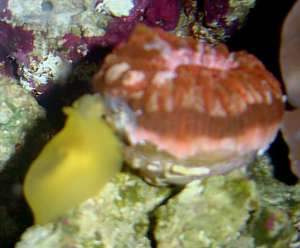
Hello,
I hope your doing great. Last night I happened to take a look at my reef tank through a video camera with a night scope. I noticed that something large, as big as my thumb, was on my button coral.
I turned on the lights, and it was a yellow nudibranch. I think. Can you tell me by the picture if this is a coral eating slug and what kind it is? It looks as though it did damage to the button. I just lost a bubble coral recently, and I never lose my corals. Should I be worried?
Thanks for your help!
Steven O. Garcia
steven.garcia@diversityworking.com
Garcia, S., 2004 (Feb 3) Coral-feeding Berthellina. [Message in] Sea Slug Forum. Australian Museum, Sydney. Available from http://www.seaslugforum.net/find/12078Dear Steve,
It would be helpful to have some clues as to where your yellow slug might have come from. Even without knowing that, I am pretty sure your yellow animal is a species of Berthellina and probably Berthellina citrina. It is a sea slug, but not a nudibranch. It belongs to a group called the Notaspidea, or side-gilled slugs, because they have their gill on the right side of the body,usually hidden in the space on the right side of the body between the upper mantle and the foot.
I'm afraid the news is not good for your bubble coral - nor I suspect for the Berthellina when you read this. Species of Berthellina have often been reported to feed on sponges but Bertsch & Johnson (1981) reported that in Hawaii they also eat various corals. Have a look at Scott Johnson's earlier message. I don't think they have been observed eating 'Bubble corals' but I am afraid there is no reason why they shouldn't find them tasty. I guess you will not be that pleased to have advanced our knowledge of feeding in this species but hopefully you will be in time to save your coral.
It would be useful to clarify what your 'Bubble Coral' is, as your observation is quite interesting. Would you know if it is Plerogyra sinuosa, which is a species from the tropical Indian and Pacific Oceans?
• Bertsch, H., & S. Johnson. 1981. Hawaiian nudibranchs, a guide for SCUBA divers, snorkelers, tidepoolers, and aquarists. 112 pp. Oriental Publishing Co., Hawaii
Best wishes,
Bill Rudman
Berthellina citrina from sthn Queensland
December 18, 2003
From: Gary Cobb
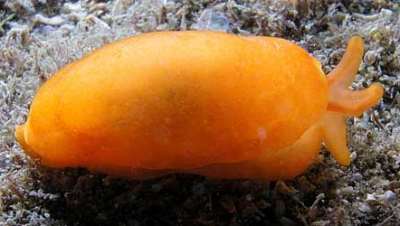
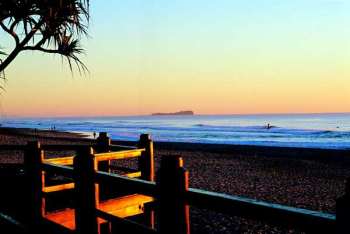
Hi Bill!
Please find attached photos of Berthellina citrina I found under a rock during a morning dive at Old Woman Island on the Sunshine Coast off Mooloolaba, southern Queensland, Australia.
Depth 10m
Water temp 23C
Day time
Length 30mm
The dives around Old Woman Island are alive with Opisthobranchs. I wonder why? Maybe the rocky coral bottom as well as being near (about 2 kms) a major river mouth. I have dived the site around Old Woman Island for about 2 years and no matter how much I dive it it still yields many great secrets! The depths range from 5m to 15m so the average dive time is over an hour. Attached is a photo taken in the morning of the island from the beach ... don't you think the island looks a bit like a nudibranch?
Cheers,
Gary Cobb
gary@cobb.com.au
Cobb, G., 2003 (Dec 18) Berthellina citrina from sthn Queensland. [Message in] Sea Slug Forum. Australian Museum, Sydney. Available from http://www.seaslugforum.net/find/11693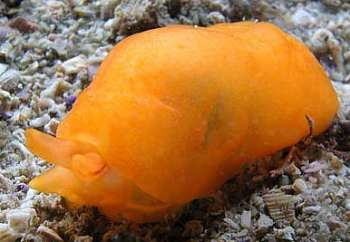
Thanks Gary,
I suspect you would have to me a bit of a nudibranch fanatic to think the island looks like one, so I will be polite and agree with you. Your photo alongside shows the head, with rolled rhinophores and oral veil, very well
Best wishes
Bill Rudman
Berthellina citrina - Dent rock, Jervis Bay
November 12, 2003
From: Sue Newson
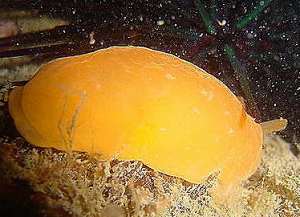
To accompany my last message, here is a photo of Berthellina citrina from the same dive.
Dive details:
Site: Dent Rock, Jervis Bay
22 November 2002 9.30pm - 10.30pm
average depth: 3m (where pleurobranchs were found)
Viz 2m in torch light.(good for this spot)
Water temp: 19*C
Low tide
Sue Newson
snewson@shoal.net.au
Newson, S., 2003 (Nov 12) Berthellina citrina - Dent rock, Jervis Bay. [Message in] Sea Slug Forum. Australian Museum, Sydney. Available from http://www.seaslugforum.net/find/11304Thanks Sue,
Bill Rudman
Berthellina citrina eggs
April 8, 2003
From: Kirsten Benkendorff
Dear Bill,
I have just seen Ian Hutton's posting concerning Berthellina citrina egg mass and can confirm that these are very likely to be from this species - I have had them laying in aquaria and they egg mass and egg size looks exactly like the pictures. Sorry it has taken me a few months to reply!!
Kirsten
kirsten.benkendorff@flinders.edu.au
Benkendorff, K., 2003 (Apr 8) Berthellina citrina eggs. [Message in] Sea Slug Forum. Australian Museum, Sydney. Available from http://www.seaslugforum.net/find/9590Thanks Kirsten,
Replies are always welcome - there is no time limit, especially when questions remain unanswered. I hope you have now settled in to your new job in South Australia. Look forward to hearing from you again
Best wishes,
Bill Rudman
Berthellina citrina egg mass? from Lord Howe Island
January 14, 2003
From: Ian Hutton
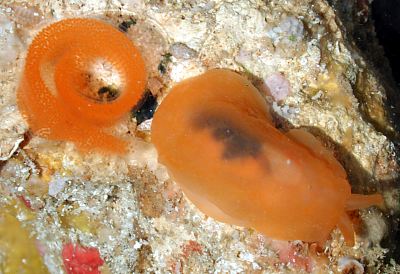
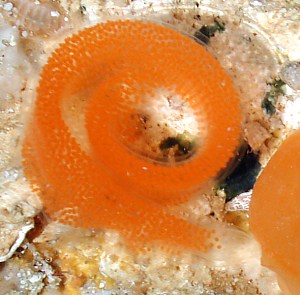
Thanks for the great site Bill. I browse every few weeks and was pleased to see your recent inclusion of some of my images from Lord Howe Island. I was going to post a few of the pics with eggs that may interest your viewers, but you have done so. I include here a pic of Berthellina citrina with eggs. I am not sure if this one was with the images I sent you. It is from Neds Beach.
Ian
alfa@tpgi.com.au
Hutton, I., 2003 (Jan 14) Berthellina citrina egg mass? from Lord Howe Island. [Message in] Sea Slug Forum. Australian Museum, Sydney. Available from http://www.seaslugforum.net/find/8820Dear Ian,
Thanks again for permission to use your photos. There are quite a few more which I will gradually add as time permits. Yes I did have this photo, but I was going to check with you whether you actually saw this egg ribbon being laid. In the lower photo, the end of the egg ribbon seems to still be attached to the rightside of the slug. Close proximity does not necessarily mean 'parenthood'. I am not sure I have ever seen the egg ribbon of Berthellina so if anyone who has can confirm its identity I would be grateful.
Best wishes,
Bill Rudman
Berthellina citrina from Reunion Island
November 12, 2002
From: Marina Poddubetskaia
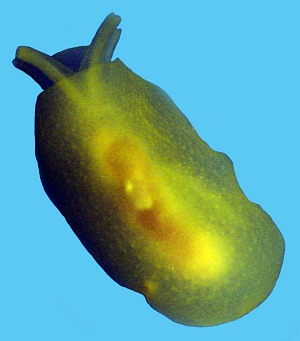
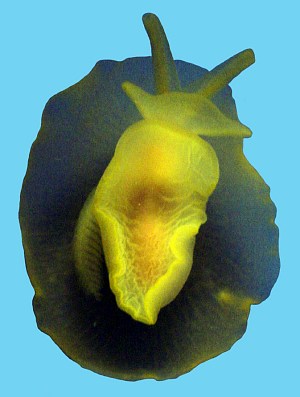
Dear Bill,
I found this pale yellow notaspid under a dead coral in Reunion. But there were large waves : impossible to take photos there. So, I photographed this animal in the tank. Is it Berthellina citrina?
Thanks again for all your help.
St-Leu, Reunion Island, Indian Ocean. Site: Le platier de la Pointe au Sel. Depth: 22m. Size: 20-25mm. October 07, 2002. Photos: Marina Poddubetskaia - Nembro website
Best wishes,
Marina
nembro@nembro.info
Poddubetskaia, M., 2002 (Nov 12) Berthellina citrina from Reunion Island. [Message in] Sea Slug Forum. Australian Museum, Sydney. Available from http://www.seaslugforum.net/find/8277Dear Marina,
Considering the difficulties of identifying Atlantic /Mediterranean pleurobranchs which look like this I am hesitant to be confident. However, I am pretty sure this is Berthellina citrina. The blue background seems to have given quite a dark greeny look to your photos. At this size, B. citrina is usually quite translucent with and orange or yellowish tinge.
Best wishes,
Bill Rudman
What sort of slug is it?
November 30, 2001
From: Chris
hi can you please help me,
About a week ago I found a slug at Swansea (NSW, Australia) I put it in my saltwater tank and it died a few days later and the tank began to smell and the fish acted as though something was attacking their skin, and gulped lots of water.
Slug was about 2cm round and it was a fluro orange see through blob. but when it was put down it began to open and move on one side it had like a feathered shaped thing. After looking around the web I found what it sort of looks like. It has a resemblance to Pleurobranchus forskalii (Ruppell & Leuckart, 1828) [Order: NOTASPIDEA; Family: Pleurobranchidae]
But its back was smooth like jelly. Is it poisonous? I'm still standing after touching it but is it toxic to other tank mates.
Thanks in advance
chris
chris@startcomputing.com.au
Chris, 2001 (Nov 30) What sort of slug is it?. [Message in] Sea Slug Forum. Australian Museum, Sydney. Available from http://www.seaslugforum.net/find/5751Dear Chris,
Forom you description think your animal was Berthellina citrina which is related to Pleurobranchus forskalii. They are both pleurobranchs, which are sometimes called Side-gilled slugs because they have their gill (the feather shaped thing in your description) on the right side of the body.
Is it poisonous? If you look at the Defensive Glands Page, you will find a photo of the skin of Berthellina citrina showing the white acid glands it has in its skin. They certainly are nasty to taste so I guess fish wouldn't be that happy swimming around in the secretions. You mention the fish were gasping etc. I suspect that may have been a combination of any skin gland secretions and from the decay normally associated with dead and dying animals. Nudibranchs and other sea slugs with relatively thin skins tend to decay quite rapidly, and once the body wall rots away the rotting internal viscera and associated digestive enzymes etc escape into the surrounding water - not a pleasant environment for fish and other living creatures. It's always a good idea to remove sick and dead animals and plants from an aquarium. Even those that aren't poisonous or toxic when alive, rapidly become so when they begin to decompose.
Best wishes,
Bill Rudman
Feeding observations on Berthellina citrina
December 13, 2000
From: Scott Johnson
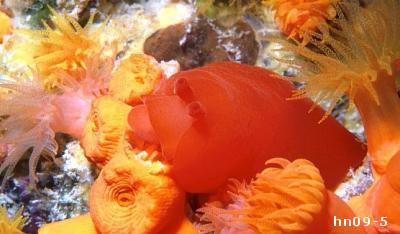
Hi Bill,
I hadn't planned to add to the backlog before your trip, but Jennifer Whitacre's question about feeding in Berthellina prompted me to dig a few more pictures out. I have seen B. citrina in Hawaii eating a variety of sponges and hard corals, including Tubastraea (hn09-1, hn09-5), Leptastraea (hn09-7), a white sponge (hn09-2), and a red encrusting sponge (hn09-4). While I have no photos, I've also found specimens eating the coral Porites and a couple of other encrusting sponges.
Scott
johnson@kmrmail.kmr.ll.mit.edu
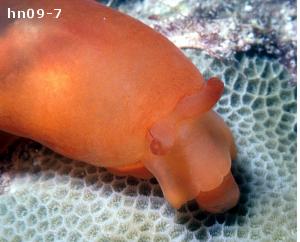
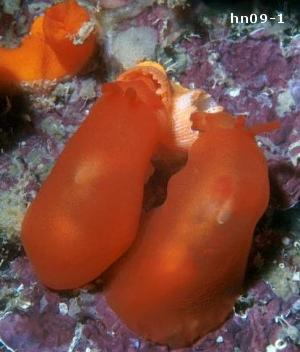
Dear Scott,
Thanks for the photos of Berthellina feeding. I have separated the two sponge feeding photos into a separate message. For those of you unfamiliar with these animal's anatomy, the small remnant shell can be clearly seen through the very thin skin in photo hn09-1
Bill Rudman.
Feeding in Berthellina citrina (2)
December 13, 2000
From: Scott Johnson
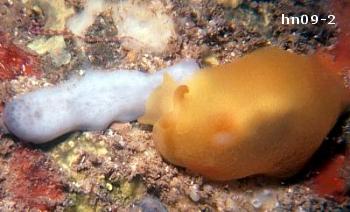
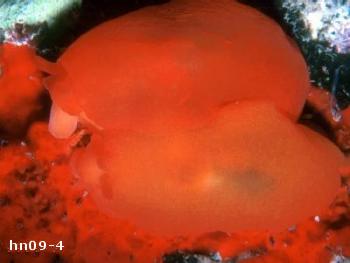
Here are two of Scott Johnson's photos to accompany his message on feeding in Berthellina citrina. These photos, also from Hawaii are of feeding on a white sponge (hn09-2.jpg), and a red encrusting sponge (hn09-4.jpg).
Johnson, S., 2000 (Dec 13) Feeding in Berthellina citrina (2). [Message in] Sea Slug Forum. Australian Museum, Sydney. Available from http://www.seaslugforum.net/find/3371Berthellina citrina from southern New South Wales
January 26, 2000
From: Dave Harasti
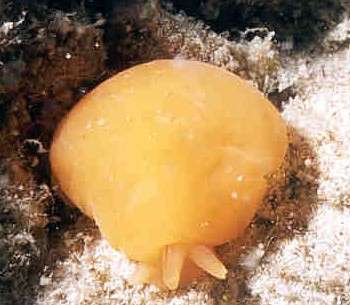
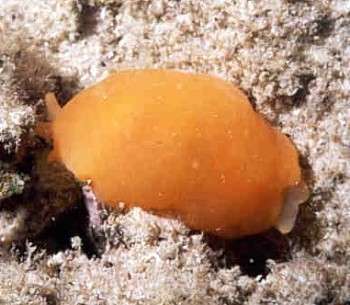
Bill,
I'm having trouble identifying this species. Photo's were taken in Jervis Bay [southern New South Wales, Australia] in about 3 metres of water with water temp about 22 degrees. It was also during a night dive and it looked like it was feeding as it was moving pretty quick!
Cheers,
Dave Harasti
http://www2.dynamite.com.au/davidh/nuddie.html
davidh@dynamite.com.au
Harasti, D., 2000 (Jan 26) Berthellina citrina from southern New South Wales. [Message in] Sea Slug Forum. Australian Museum, Sydney. Available from http://www.seaslugforum.net/find/1777Dear Dave,
This is a 'side-gilled' slug or pleurobranch called Berthellina citrina. B. citrina feeds on sponges, corals and possibly other colonial animals, so it doesn't need to move fast to catch its prey. It does tend to live in shaded places and in shallow water is usually found under rocks during daylight, being more active at night. Perhaps your animals were moving away from your light.
Best wishes,
Bill Rudman.
